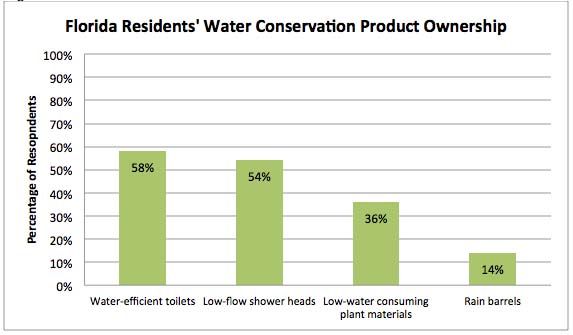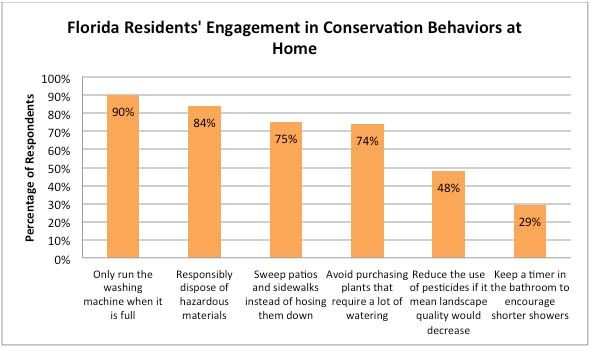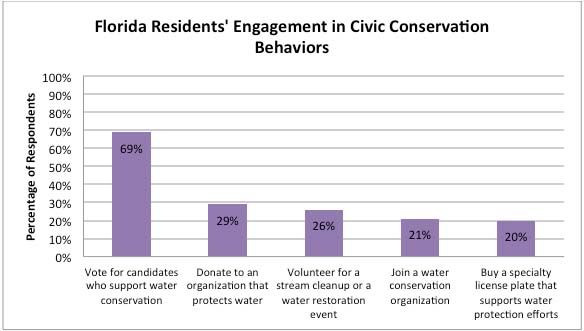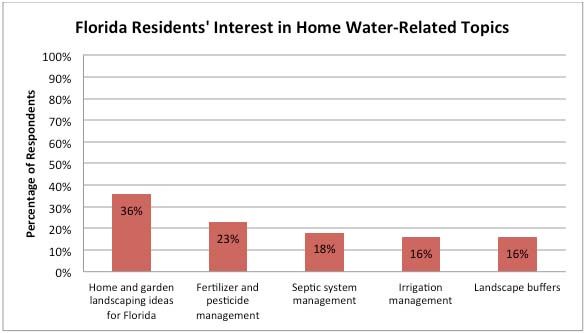Introduction
Water scarcity and poor quality of water for human consumption are two of the main environmental challenges individuals will face this century (Corral-Verdugo, Bechtel, & Fraijo-Sing, 2003). As the population of the world continues to increase, more people than ever are reliant on water for consumption to maintain life, putting a strain on water resources across the globe and making water conservation increasingly important.
Research has shown individuals will engage in water conservation practices to comply with a conservation campaign, to avoid financial ramifications and to avoid negative social connotations (Corral-Verdugo, Bechtel, & Fraijo-Sing, 2003). While research has examined the motivations behind participation in water conservation, little is known about an individual's willingness to engage in new conservation behaviors or what information individuals would like to receive about water conservation.
With a growing urban population and increased demands on water for recreational and agricultural purposes, Florida will have to identify a solution to its water quality and quantity issues. According to the UF/IFAS Extension 2013–2023 Florida Extension Roadmap, enhancing and protecting water quality, quantity, and supply is considered a high-priority initiative (University of Florida Institute of Food and Agricultural Sciences Extension, 2013). As the promotion of water conservation becomes increasingly important at the state level, Extension's role in educating consumers about water conservation will also grow. Although all Florida residents will play a part in conserving water in the future, the ability of Extension faculty to work with consumers and encourage new water conservation behaviors at home will be vital. This EDIS publication provides information to Extension faculty about the water conservation behaviors in which Florida residents currently engage, water conservation product ownership, and public interest in water-related topics.
Background
In December 2013, the UF/IFAS Center for Public Issues Education in Agriculture and Natural Resources (PIE Center) conducted an online survey of Florida residents. A total of 516 completed responses were collected from Florida residents age 18 and older (Odera & Lamm, 2014). The data were weighted to balance their geographic location in the state, age, gender, and race in order to ensure respondents and responses were representative of the 2010 U.S. Census (Kalton & Flores-Cervantes, 2003; Odera & Lamm, 2014). The survey included questions about Florida residents' perceptions of water quality and quantity, the perceived importance of water as a state issue, the importance of water, current engagement in water conservation behaviors, willingness to engage in water conservation behaviors and interests in topics related to water.
Results
Water Conservation Product Ownership
Respondents were asked whether or not they own products in their home that assist in conserving water (Figure 1). A majority of respondents owned water-efficient toilets (58%) and low-flow shower heads (54%). Only 36% of respondents indicated having low-water-consuming plant materials in their yard, and an even lower number of respondents (14%) indicated using rain barrels to collect water for use on their lawn or garden.

Engagement in Conservation Behaviors
Respondents were asked to indicate their likeliness of engaging in a variety of behaviors which could help reduce water use and protect the environment. Respondents were asked about behaviors they could engage in at home, as well as civic behaviors. Included in these categories were behaviors such as voting to support water conservation programs, using biodegradable cleaning products, only watering lawns in the morning or evening, and sweeping patios and sidewalks instead of hosing them down.
When it came to the behaviors respondents could engage in at home (Figure 2), respondents were most likely to only run the washing machine when it is full (90%), responsibly dispose of hazardous materials (84%), sweep patios and sidewalks instead of hosing them down (75%), and avoid purchasing plants that require a lot of watering. Respondents were less likely to reduce the use of pesticides if it meant their landscape quality would decrease (48%) or to keep a timer in the bathroom to help them take shorter showers (29%).

When it comes to engaging in civic behaviors related to water conservation (Figure 3), respondents were overall less likely to engage in these behaviors than those listed above. Respondents were the most likely to vote for candidates who support water conservation (69%), donate to an organization that protects water (29%), and volunteer for a stream cleanup or a wetland restoration event (26%). Respondents were least likely to join a water conservation organization (21%) or buy a specialty license plate that supports water protection efforts (20%).

Interest in Water Topics
Respondents were asked to indicate their interest in water-related topics affecting their homes and lawns, as well as in water-related environmental topics such as watershed management, fertilizer and pesticide management, fish and wildlife water needs, and private well protection. Respondents were encouraged to select all topics in which they were interested from the list.
Respondents indicated moderate interest in water-related topics affecting their homes (Figure 4). They were most interested in learning about home and garden landscaping ideas for Florida (36%), fertilizer and pesticide management (23%), septic system management (18%), irrigation management (16%), and landscape buffers (16%). Respondents indicated less interest in water-related topics affecting the environment. Respondents were least interested in private well protection (15%), forest management and water issues (15%), watershed restoration (13%), and watershed management (12%).

Recommendations
All Florida residents play a role in conserving water. Extension's role in encouraging water conservation behaviors among Florida residents is only expected to grow in the next 10 years as the Florida Extension Roadmap is put into action and works toward enhancing and protecting water quality and quantity in the state. By better understanding the water conservation behaviors Florida residents currently engage in, as well as the behaviors they are willing to engage in, Extension faculty will be better equipped to advise clientele on how to conserve water. Furthermore, by understanding what water-related topics are of interest to Florida residents, Extension faculty will be able to incorporate topics of interest into their programming and make it more meaningful to diverse audiences.
When advising clients on ways to conserve water, Extension faculty should recommend small behavior changes inside the home. A majority of Florida residents are already engaged in commonly suggested behaviors such as using a low-flow shower head (54%) or water-efficient toilet (58%). Extension faculty should emphasize additional behaviors such as turning off the water when you brush your teeth and only running the dishwasher or washing machine when they are full. Although these may be small changes, they can result in long-term water conservation. According to the Untied States Environmental Protection Agency (2014), by installing low-flow shower heads the average family save can up to 2,900 gallons of water a year.
Extension faculty should focus on encouraging outdoor water conservation behaviors, such as purchasing low-water-consuming plants and properly managing pesticides. Respondents indicated high levels of likeliness to participate in outdoor conservation behaviors, as 74% of respondents indicated they were highly or somewhat likely to purchase plants that needed less water for their yards and 48% indicated they would use less fertilizer in their yards.
To meet respondents' interests in outdoor water conservation behaviors, Extension faculty should consider conducting educational programs which showcase available low-water-consuming plants. Extension faculty should also educate clientele on proper fertilizer application and ways to use fewer pesticides on their yards. Extension faculty should also advise clientele to participate in the Florida-Friendly LandscapingTM Program. Information regarding pest management, fertilizer application, plant selection, stormwater management, and landscape design can all be found on their website https://ffl.ifas.ufl.edu/.
Although Florida residents reported they were less likely to engage in civic water conservation programs, involvement in these programs should be encouraged to allow residents to have a greater impact on water conservation. Extension faculty should recommend clientele become involved with water conservation organizations and give back to their local community through donations or volunteering. Extension faculty should also encourage clientele to learn about political candidates' or groups' opinions on water quantity and quality issues, and consider these opinions when electing candidates for office. When working with political candidates or opinion leaders, Extension faculty should encourage them to become involved with water conservation organizations and make their ideas regarding water quality and quantity issues public.
When developing new or revising existing programming, Extension faculty should consider incorporating information on both home and environmental water-related topics. Respondents indicated high levels of interest in topics related to indoor and outdoor water conservation behaviors. By incorporating these topics into a wide range of Extension programming, Extension faculty will be able to effectively and efficiently communicate with their clients about water conservation, and encourage water conservation practices among Florida residents.
References
Corral-Verdugo, V., Bechtel, R. B., & Fraijo-Sing, B. (2003). Environmental beliefs and water conservation: An empirical study. Journal of Environmental Psychology, 23(3), 247–257. Retrieved from https://www.sciencedirect.com/science/article/abs/pii/S0272494402000865.
Kalton, G., & Flores-Cervantes, I. (2003). Weighting methods. Journal of Official Statistics, 19(2), 81–97.
Odera, E., & Lamm, A. (2014). Public opinion of water in Florida. PIE2012/13-06. Gainesville, FL: UF/IFAS Center for Public Issues Education.
United States Environmental Protection Agency, Office of Wastewater Management. (2014). "Showerheads." WaterSense. Retrieved from https://www.epa.gov/watersense/showerheads.
University of Florida Institute of Food and Agricultural Sciences Extension. (2013). Shaping solutions for Florida's future: The UF/IFAS extension roadmap 2013–2023. Retrieved from https://pdec.ifas.ufl.edu/roadmap/FloridaExtensionRoadmap_2013-2023.pdf.